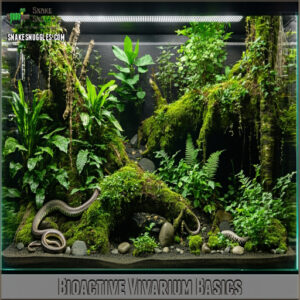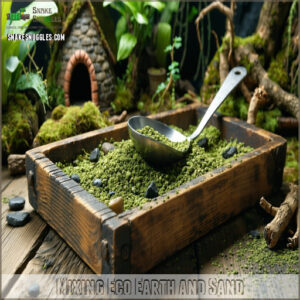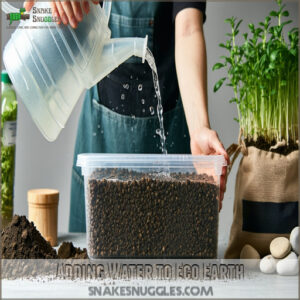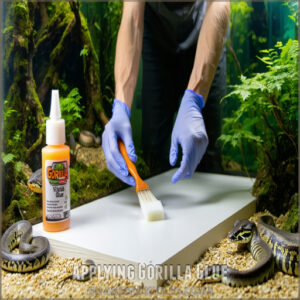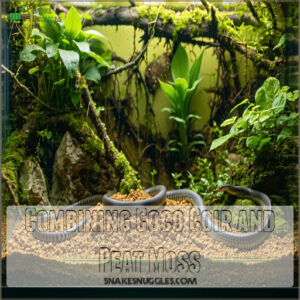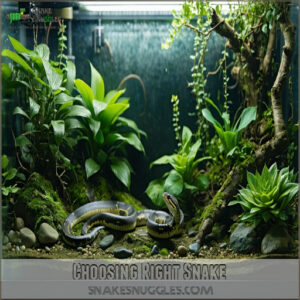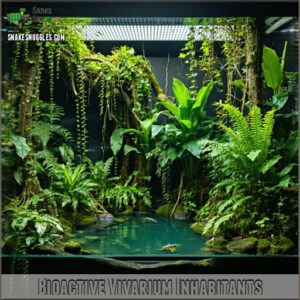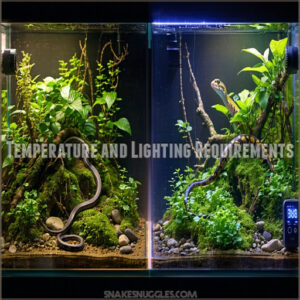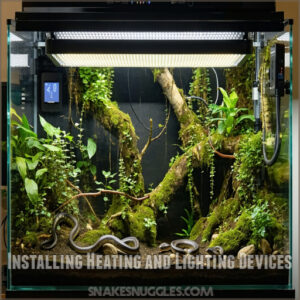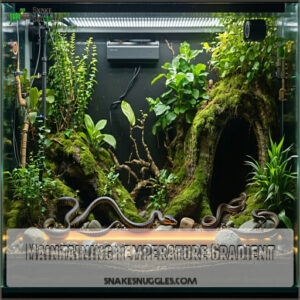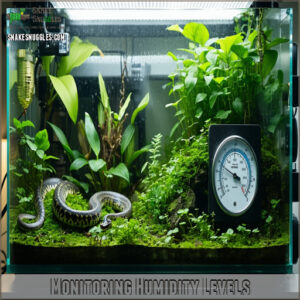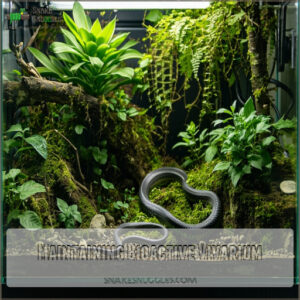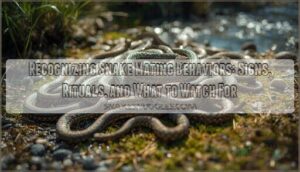This site is supported by our readers. We may earn a commission, at no cost to you, if you purchase through links.
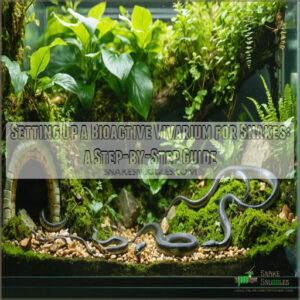 Setting up a bioactive vivarium for snakes means creating a mini-ecosystem that practically runs itself.
Setting up a bioactive vivarium for snakes means creating a mini-ecosystem that practically runs itself.
Start with a drainage layer (gravel or Hydroton, about 3 inches deep) to avoid swampy conditions.
Next, add a bioactive substrate—mix coco coir, peat moss, and sand—to retain moisture and support burrowing.
Toss in leaf litter for humidity control and a cozy habitat for your clean-up crew (springtails and isopods are your MVPs here).
Plant snake-safe greenery for aesthetics and extra oxygen.
Finally, choose a snake species that suits this environment.
Done right, it’s like giving your snake a five-star jungle vacation—minus mosquitoes!
Table Of Contents
- Key Takeaways
- Bioactive Vivarium Basics
- Creating Bioactive Substrate
- Choosing Right Snake
- Bioactive Vivarium Inhabitants
- Setting Up Vivarium Environment
- Maintaining Bioactive Vivarium
- Frequently Asked Questions (FAQs)
- How to build a bioactive snake enclosure?
- What is a snake vivarium?
- How do I set up a bioactive vivarium?
- How can a bioactive snake enclosure help a picky reptile?
- Do you need a snake vivarium?
- How do you choose a bioactive substrate for a snake?
- How to set up a bioactive snake enclosure?
- Is a bioactive terrarium good for snakes?
- What is the best bioactive substrate for snakes?
- Do bioactive snake enclosures smell?
- Conclusion
Key Takeaways
- Start with a bioactive substrate mix and a drainage layer to prevent waterlogging and mimic natural conditions.
- Add a cleanup crew like springtails and isopods to break down waste and maintain the ecosystem.
- Include snake-safe live plants for humidity control and to create hiding spots for enrichment.
- Maintain proper temperature and humidity with reliable heat sources, lighting, and a hygrometer.
Bioactive Vivarium Basics
Creating a bioactive vivarium starts with understanding its key components.
These elements work together to mimic natural habitats.
Supporting a self-sustaining ecosystem for your snake.
Essential Components
A bioactive vivarium setup requires thoughtful terrarium components like snake hides, decorative elements, and water features.
Start with a drainage layer to prevent waterlogging and choose substrate options based on snake needs. Maintain proper substrate depth for burrowing and plant support.
Incorporate bioactive substrate to mimic natural habitats, ensuring a comfortable vivarium design adapted for your snake’s health and happiness.
When selecting materials, consider the importance of suitable vivarium substrate for a thriving ecosystem.
Drainage Layers
When setting up your vivarium, don’t skip the drainage layer—it’s the unsung hero of water management.
Gravel options, Hydroton clay balls, or other drainage materials prevent waterlogging and keep the bioactive substrate healthy.
Aim for a 3-inch depth to maintain moisture control.
It’s like giving your terrarium design a solid foundation, ensuring stability and happy, thriving plants and critters.
Bulk Substrates
After adding a drainage layer, it’s time to build your vivarium substrate. A good substrate mix supports burrowing and plant roots while maintaining proper moisture. Combine Coco Husk, Orchid Bark, and a Soil Mix for a natural feel.
Here are key substrate options:
- Coco Husk for texture.
- Orchid Bark adds structure.
- Soil Mix maintains balance.
- Gravel Base prevents soggy conditions.
Maintain substrate depth for snake comfort. A well-designed bioactive substrate requires understanding of bioactive systems to create a thriving environment.
Leaf Litter
A well-prepared leaf litter layer is essential in your bioactive vivarium. It supports the decomposition process, regulates humidity, and offers a microfauna habitat. Choose different leaf types for variety and make sure proper litter depth. Here’s a quick breakdown:
| Benefit | Description |
|---|---|
| Decomposition Process | Enriches the bioactive substrate |
| Humidity Control | Prevents overly dry environments |
| Microfauna Habitat | Supports springtails and isopods |
Keep it diverse with live plants and substrate options!
Creating Bioactive Substrate
Creating a bioactive substrate is essential for mimicking a snake’s natural habitat and maintaining a healthy, self-sustaining ecosystem.
You’ll need to carefully mix materials like coco coir, peat moss, and sand to achieve the right balance for plant growth, burrowing, and moisture retention.
Mixing Eco Earth and Sand
Your ideal substrate mix combines Eco Earth with sand in carefully measured proportions to create a stable foundation. Mix these components until you achieve a consistent texture that holds moisture without becoming waterlogged.
For ideal results, incorporate additional elements like sphagnum moss, bark, and activated carbon. This bioactive substrate mixture provides essential nutrients and prevents compaction, supporting a thriving vivarium ecosystem for years to come.
To achieve a balanced ecosystem, understanding vivarium ecosystem balance is essential for maintaining a healthy environment.
Adding Water to Eco Earth
The key to proper Eco Earth mixing lies in gradual water absorption. Pour water slowly over your compressed brick until it begins expanding – this typically takes about 2-3 cups per brick.
You’ll notice the substrate’s volume increase dramatically as it hydrates. Once you’ve achieved a soil-like consistency that holds shape when squeezed but doesn’t drip water, your bioactive vivarium substrate is ready for the next step.
Proper substrate selection is paramount for maintaining a healthy environment. This includes understanding snake housing substrate.
Applying Gorilla Glue
Now that your Eco Earth has expanded, it’s time to focus on glue application.
Gorilla Glue creates a strong foundation for your bioactive vivarium‘s background.
Before applying adhesive, prepare your surface with these proven bonding techniques:
- Clean the enclosure’s back panel thoroughly with rubbing alcohol.
- Apply thin, even layers of glue using a foam brush.
- Let each layer dry for 24 hours to guarantee proper adhesion.
Your vivarium setup’s success depends on this solid foundation.
Combining Coco Coir and Peat Moss
The balanced combination of coco coir and peat moss creates a perfect foundation for your bioactive vivarium. You’ll want to mix these components in a 70/30 ratio, with coco coir forming the majority.
This substrate depth should reach 2-3 inches for best moisture levels and soil quality.
When blending, make sure the materials are thoroughly combined to maintain consistent moisture distribution throughout your snake’s habitat.
Choosing Right Snake
You’ll want to start your bioactive vivarium journey with beginner-friendly snakes like ball pythons or corn snakes, which adapt well to these naturalistic setups.
These species thrive in bioactive environments and stay at a manageable size of 3-5 feet.
You’ll need to match your substrate choice to your snake’s specific needs, considering factors like burrowing habits and humidity requirements.
Ball Pythons as Beginner Snakes
After setting up your bioactive substrate, you’ll want a snake that thrives in this environment.
Ball pythons are perfect for beginners venturing into bioactive vivariums. These gentle creatures reach a manageable 3-5 feet and adapt well to handling.
Your python care journey becomes easier with their docile temperament and straightforward feeding habits. They’re like the golden retrievers of the snake world – friendly and forgiving.
For effective care, understanding exotic pet needs is essential to create a suitable environment. exotic pet needs
Corn Snakes and Their Adaptability
While ball pythons excel in captivity, corn snakes take adaptability to another level in bioactive vivariums. These vibrant reptiles thrive in varied snake habitats, making them perfect for both beginners and experts. Here’s why corn snakes shine in bioactive setups:
- They actively explore multiple temperature zones, maximizing your vivarium design.
- Their climbing behavior helps maintain plant health.
- They adapt quickly to bioactive substrates, rarely showing stress in new environments.
Selecting a Bioactive Substrate
Now that you’ve got your corn snake settled, let’s focus on creating the perfect home base – your bioactive substrate.
Your substrate choice needs a careful mix of soil and organic matter that holds moisture without getting waterlogged.
Start with a 3-inch substrate depth using ABG mix combined with coco coir.
This blend provides excellent substrate stability while supporting your cleanup crew and maintaining proper moisture control.
When selecting a substrate, consider the importance of moisture retention properties to maintain the health and wellbeing of your snake.
Bioactive Vivarium Inhabitants
You’ll need a small cleanup crew of springtails and isopods to maintain your bioactive vivarium, as these tiny workers break down waste and uneaten food into nutrients for your plants.
Your snake’s habitat will also benefit from carefully selected live plants that regulate humidity and provide natural hiding spots, creating a slice of the wild right in your home.
Springtails and Isopods for Waste Management
Working tirelessly beneath the surface, springtails and isopods form your vivarium’s essential cleanup crew.
These tiny custodians excel at different tasks: springtails tackle mold control, while isopods break down organic waste.
You’ll find these microfauna thriving in humid areas of your bioactive substrate, particularly under water dishes and within leaf litter.
Together, they maintain a healthy bioactive terrarium ecosystem through efficient waste breakdown.
Fungi and Other Organisms for Breakdown
While fungi mightn’t be the showstoppers of your bioactive substrate, they’re essential decomposers working behind the scenes. These beneficial organisms break down organic matter and maintain microbe balance in your vivarium’s ecosystem health.
- Mycorrhizal fungi form partnerships with plant roots, enhancing nutrient uptake
- Saprophytic fungi decompose dead organic materials
- Beneficial bacteria aid in waste breakdown
- Nematodes help control harmful microorganisms
- Actinomycetes give soil that fresh earth smell
The orchestrated efforts of these microorganisms create a self-sustaining ecosystem that’ll keep your snake’s habitat thriving.
Introducing The Clean-up Crew to The Terrarium
The delicate dance of introducing your Clean Up Crew begins with patience. Delicate dance is the foundation of establishing a balanced ecosystem.
You’ll want to add your microfauna gradually, starting with springtails to establish the foundation of your ecosystem balance.
Once they’re settled, introduce isopods to complement the decomposer role. Wait a week between adding different cleanup crew members, allowing each group to establish their territory in the bioactive substrate, ensuring successful terrarium inhabitants.
Live Plants for Humidity Regulation
Live plants serve as natural humidity regulators in your snake’s bioactive vivarium. When selecting vivarium plants, choose species that thrive in your snake’s preferred humidity levels and create beneficial microclimates.
Finding the best plants for bioactive vivariums is essential for success. Plants actively participate in water cycling, releasing moisture through transpiration while their roots help maintain bioactive substrate moisture.
Position leaf litter strategically around plant bases to enhance humidity control and provide cover for your snake.
Setting Up Vivarium Environment
You’ll need to create a comfortable environment in your snake’s bioactive vivarium by maintaining temperatures between 70-95°F and humidity levels between 40-60%.
Once you’ve installed the proper lighting and heating equipment, you can establish a temperature gradient that allows your snake to regulate its body temperature naturally, just as it would in the wild.
Temperature and Lighting Requirements
Temperature control in your snake’s bioactive vivarium requires careful attention to both heating and lighting.
You’ll need to maintain a warm side at 85-90°F and a cool side at 75-80°F, creating an essential thermal gradient.
Different heat sources, from ceramic emitters to heat mats, help achieve this balance.
For effective results, use a reliable thermostat to monitor and adjust temperatures consistently.
Installing Heating and Lighting Devices
Start with reliable heat sources like a heat pad or radiant heat panel and pair them with proper lighting options, including UVB lighting if your snake requires it.
For precise temperature control, invest in a good thermostat. Creating a proper temperature gradient is vital for snake comfort and well-being. Always double-check thermostat settings and equipment placement to avoid overheating.
A mix of light and heat creates a comfortable environment for your snake. Consider a suitable snake lighting schedule to facilitate a healthy day-night cycle.
Maintaining Temperature Gradient
Picture a stretch of sunlight and shadow—your vivarium should mirror that balance.
Maintain a thermal gradient by placing heat sources like lamps or pads strategically. Use a thermostat for precise temperature control.
Provide cooler areas for thermoregulation. Snakes thrive when they can move between warm and cool zones.
Gradient maintenance is important for their comfort and health.
Monitoring Humidity Levels
Keeping humidity levels steady keeps your snake happy and healthy. Use a hygrometer to regularly check moisture levels, aiming for species-specific humidity needs. For fine-tuning, consider fogging systems or water cycling.
Balance temperature and humidity gradients carefully—too much moisture can invite mold. Keep an eye on condensation; it’s a quick humidity control cheat sheet for fine-tuning conditions effortlessly.
Maintaining Bioactive Vivarium
Caring for a bioactive vivarium means keeping its ecosystem balanced and thriving.
You’ll need to monitor conditions regularly, trim plants, and refresh the substrate to maintain a healthy environment for your snake.
Avoiding Dramatic Changes
It’s essential to avoid dramatic changes when maintaining your bioactive vivarium. Gradual acclimation helps keep stable environments and healthy conditions for your snake. A consistent approach makes sure substrate depth, moisture control, and thermal gradients remain balanced.
- Avoid sudden temperature shifts.
- Adjust humidity gradually.
- Maintain a stable substrate.
- Replenish moisture levels slowly.
- Monitor thermal gradients for consistency.
Monitoring The Terrarium’s Health
Regular health checks keep your vivarium thriving. Monitor temperature and humidity daily to maintain terrarium balance. Check the drainage layer and substrate condition to avoid waterlogging.
Watch your snake’s wellness—relocate to a sterile setup if needed. Replace decomposers as part of vivarium hygiene.
These steps maintain the eco system’s health, revealing bioactive benefits for both plants and inhabitants.
Making Adjustments as Needed
When you spot unusual snake behavior or changes in humidity, it’s time for environmental tweaks.
Vivarium monitoring helps you catch shifts early.
Check substrate condition and temperature levels regularly, making adjustments to keep things balanced.
Maintenance schedules are your best friend here—small fixes, like humidity control tweaks or rearranging décor, will maintain the bioactive benefits without a fuss.
Pruning Plants for Healthy Growth
Pruning live plants keeps your vivarium thriving. Pruning live plants helps maintain a healthy environment by trimming excess leaves, overgrown stems, and dead foliage to prevent overcrowding.
Follow this checklist for foliage management:
- Use sterilized scissors for leaf trimming.
- Perform stem cutting to control size.
- Conduct root pruning if plants outgrow their space.
- Remove unhealthy growth immediately.
- Preserve canopy balance for healthy bioactive substrate.
Your snake will appreciate it!
Replacing Substrate for Optimal Conditions
Over time, a bioactive substrate loses effectiveness, so proper substrate replacement is key.
Maintain a substrate depth suitable for your snake’s needs to guarantee moisture control.
Replace soil layers by mixing fresh Eco Earth.
Regular vivarium maintenance includes checking the bioactive enclosure for signs of imbalance.
Substrate mixing rejuvenates ecosystems, keeping your vivarium healthy while promoting ideal conditions for decomposition and plant growth.
Frequently Asked Questions (FAQs)
How to build a bioactive snake enclosure?
Start with a drainage layer, add a bioactive substrate blend, and top with leaf litter.
Include live plants, a cleanup crew like springtails, and décor for hiding and climbing.
Maintain proper temperature, humidity, and ventilation.
What is a snake vivarium?
A snake vivarium is a secure, customized habitat that mimics your snake’s natural environment.
It includes ideal temperature, humidity, and hiding spaces, ensuring enrichment, safety, and comfort for your slithering companion’s health and happiness.
How do I set up a bioactive vivarium?
Creating a bioactive vivarium involves layering drainage, adding mixed substrates, and incorporating leaf litter.
Introduce decomposers like isopods and springtails, include live plants for humidity, and maintain lighting, temperature, and a secure, enriching environment.
How can a bioactive snake enclosure help a picky reptile?
Did you know picky reptiles are 30% more likely to thrive in bioactive enclosures?
They mimic natural habitats, offering enrichment, moisture control, and hiding spots that encourage appetite, reduce stress, and improve overall well-being.
Do you need a snake vivarium?
If you keep a snake, a vivarium is essential.
It gives them a safe, controlled habitat resembling their natural environment.
Think of it as their personalized apartment—complete with temperature control and cozy hiding spots!
How do you choose a bioactive substrate for a snake?
Think of substrates as a bedrock for your snake’s comfort.
Blend coconut husk and soil for burrowers, or mix sand for desert species.
Choose well-draining types and mimic their natural habitat for a thriving ecosystem.
How to set up a bioactive snake enclosure?
Start by layering drainage (like gravel) and bioactive substrate. Add leaf litter, live plants, and a cleanup crew. Include hides, climbing features, and a secure lid.
Maintain proper humidity, temperature gradients, and ventilation for your snake.
Is a bioactive terrarium good for snakes?
A bioactive terrarium is great for snakes! It mimics their natural habitat, maintains humidity, encourages natural behaviors, and cuts down cleaning.
Plus, the clean-up crew keeps the environment balanced—your snake thrives, and you relax.
What is the best bioactive substrate for snakes?
You might think any dirt will do, but mix coco coir, peat moss, and organic soil for a perfect snake setup.
Add leaf litter for enrichment and a drainage layer to prevent waterlogging—your snake will thank you!
Do bioactive snake enclosures smell?
A well-maintained bioactive snake enclosure shouldn’t have a strong smell.
Decomposers like isopods and springtails break down waste, keeping odors minimal.
If you notice unpleasant smells, check for leftover food or improper humidity levels.
Conclusion
Think of setting up a bioactive vivarium for snakes like building a tiny, self-sustaining planet.
With the right drainage, substrate, and plants, you’re creating a balanced habitat where your snake thrives and nature takes care of itself.
Don’t forget to introduce hardworking cleanup crews like springtails and isopods to keep things tidy.
Monitor temperature and humidity to maintain ideal conditions.
Once established, your vivarium becomes a low-maintenance, enriching environment that benefits both you and your snake.
- https://www.thebiodude.com/collections/bioactive-snake-terrarium-kits
- https://www.reptileadvisor.com/bioactive-vivarium/
- https://www.terrariumquest.com/vivarium/bioactive/
- https://www.reddit.com/r/Vivarium/comments/l208t2/using_eco_earth_as_bioactive_substrate/
- https://exo-terra.com/explore/academy/bioactive/how-to-set-up-a-bioactive-terrarium/

